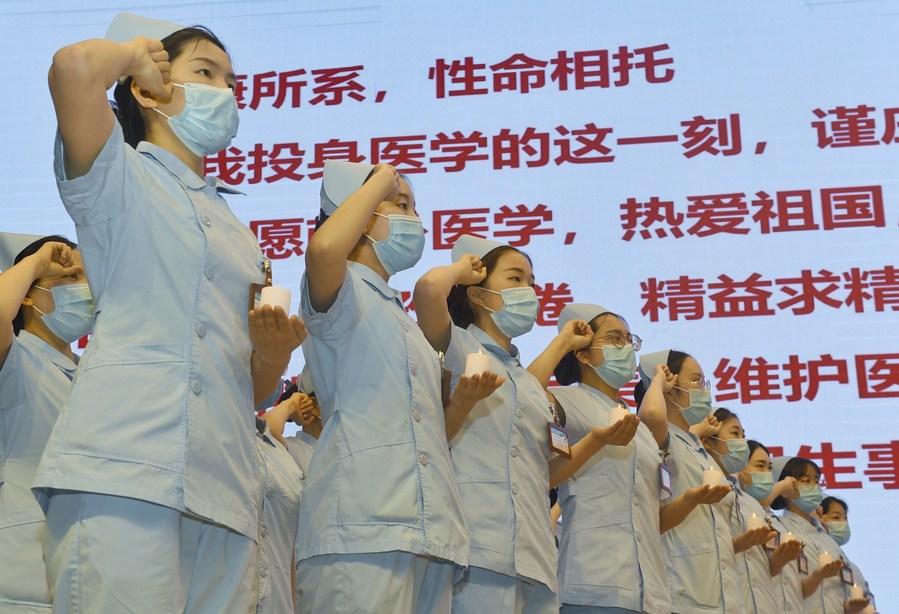
Newly recruited nurses take an oath during a cap awarding ceremony at Sichuan Cancer Hospital in Chengdu, capital of southwest China's Sichuan Province, May 12, 2020. (Xinhua/Liu Kun)
BEIJING, June 16 (Xinhua) -- Chinese experts are trying to implement uniform diagnosis and treatment protocols for cancer across the country in order to increase the survival time of patients and narrow the urban-rural gap in the way the disease is handled.
The five-year survival rate among cancer patients in China has increased to 40.5 percent from 30 percent 10 years ago, said Liu Zhihua, a professor at National Cancer Center (NCC) and Cancer Hospital, Chinese Academy of Medical Sciences, at a conference jointly organized by NCC, Cancer Foundation of China and other institutions.
Despite the improved survival rate, cancer patients in China still live less than those in the United States and some European countries as the rate of early diagnosis is relatively low in the East Asian country, Liu added.
"People living in some rural areas and remote regions may not go to the hospital for cancer screening and many cancer cases are diagnosed at an advanced stage when they are harder to treat successfully," Liu said.
According to Ma Fei, an expert at the NCC, cancer screening technology and early diagnosis methods vary a lot among areas. Some grassroots medical institutions need to improve rational drug use, treatment accuracy, and management of concomitant diseases.

Photo taken on Nov. 6, 2019, shows the ITBRA which can help check breast cancer at the AstraZeneca's booth during the second China International Import Expo (CIIE) in Shanghai, east China. (Xinhua/Zhang Yuwei)
Ma said an alliance for management of the illness, mainly focusing on breast cancer has been initiated to improve early diagnosis and chronic disease management, as well as offering demonstrations.
Comprehensive and whole-cycle treatment of cancer requires a change from disease-centered diagnosis and treatment model to a patient-centered one, Ma said, adding that efforts should be made at improving cancer awareness and screening of high-risk population.
"We should pay full attention to other health problems that cancer patients may face, including hypertension, diabetes, nausea and vomiting, and depression. We also need to involve doctors from more disciplines to jointly make reasonable treatment plans," Ma said.
Statistics show that the five-year survival rate of breast cancer patients in China has reached 83.2 percent.
Xu Binghe, a breast cancer expert and a professor at NCC, said besides screening to detect early-stage cancer, multidisciplinary treatment should be popularized to reduce the risk of concomitant diseases of breast cancer.
For some postmenopausal breast cancer patients diagnosed more than 10 years ago, cardiovascular diseases have caused more deaths than cancer itself. Some cancer drugs may also lead to abnormal bone metabolism, osteoporosis, and even fractures, Xu said.
Xu, Ma, and other cancer experts are promoting standardized diagnosis and treatment of breast cancer to grassroots medical institutions through demonstration centers. Altogether 200 hospitals have been selected for participation in the first batch of pilots for breast cancer diagnosis and treatment.
Besides, a national monitoring platform for anti-cancer drugs in clinical application also helps provide reference for policies on drug management, promoting the standardization of breast cancer diagnosis and rational drug use, and narrowing the diagnosis and treatment gap between urban and rural areas, Xu said. ■



